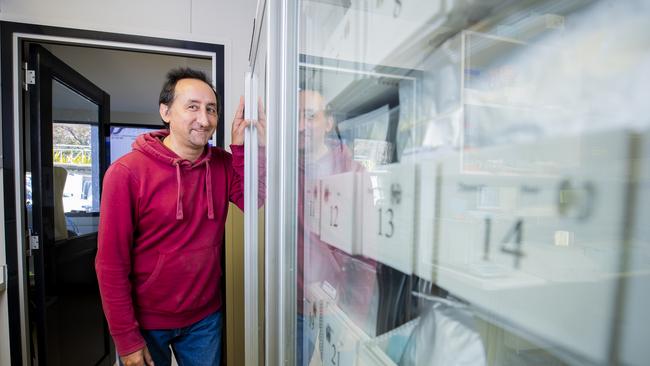Seed bank project aims to collect every seed type in Tasmania
The Tasmanian seed bank project has a goal of collecting 75 per cent of seeds from the state’s rare and threatened species by 2020, but the target has been hampered by bushfires and record dry weather.

Tasmania
Don't miss out on the headlines from Tasmania. Followed categories will be added to My News.
THE long-term security of Tasmania’s native plant species rests on the shoulders of one man, a handful of volunteers and a freezer in Hobart’s Royal Tasmanian Botanical Gardens.
As bushfire, climate change and land clearing place plant communities at increasing risk, the importance of Tasmania’s seed bank has grown much larger than its humble home.
Seed bank co-ordinator James Wood says the standard bulk freezer may look undersized for the weighty task, but it is home to 44.9 million carefully catalogued seeds.
“You don’t need much to do a lot,” Mr Wood says.
Indeed, Mr Wood is the only paid employee in the Tasmanian Seed Conservation Centre. But with the help of about 14 volunteers, the team is attempting the massive task of collecting every seed type in the state.
“We want anything and everything,” he says.
Priority is being given to the rare and threatened plant species, and so far the seed bank has 70 per cent of those precious plant communities covered.
The seeds are painstakingly collected from every corner of the state by Mr Wood and a group of about five volunteers, who sometimes have to traipse into remote wilderness for several days to claim their tiny trophies.
“Some specimens only occur on the peaks of the South West corner, and first we have to locate them, then we have to monitor them and then go back at the right time to collect seed.”
The whole process can take four to five trips, going into areas that require several days of walking.
Often volunteers are forced on hands and knees, collecting with fingers and occasionally tweezers.
Mr Wood says the process is faster by helicopter, which has been done on the rare occasion, but the expensive option relies on philanthropy.
Royal Tasmanian Botanical Gardens director Gary Davies says donations are important to the work of the seed bank.
“This year, in addition to the core funding, the RTBG Board has committed $50,000 generated through donations, to vitally important seed bank freezer room improvements and expansion,” says Mr Davies.
“This will ensure that there is sufficient capacity for seeds for the future and at the same time adequately safeguarding this important collection.”
This year a new five-year strategic plan has been adopted and implemented to manage the future work of the program.
The funding means the current freezer that is holding the specimens will move to a newly built freezer room.
The more seeds the bank can house the better, as the collection is crucial for not only the security of Tasmania’s plants but also its animals.
“It’s easy to think, ‘well, if one plant goes it doesn’t matter’,” says Mr Wood.
But plants and insects rely on the many varied plant species for food and habitat, and any loss in the ecosystem has repercussions.
Mr Wood says climate change is likely to result in more bushfires, and some species are extremely vulnerable to fire.
He says King Billy pines and pencil pines are “wiped out” by fire.
“If fire frequency starts to increase some species could be eradicated from the landscape.”
The bank has an aim of collecting 75 per cent of the seeds of state’s rare and threatened species by 2020, but the target has been hampered by bushfire and record dry weather.
The destructive bushfires of last summer wiped out two important seed collection sites at Tahune, southwest of Hobart, and in the Great Lakes district.
“The fires swept through the two main areas I had been surveying during the spring, the fire consumed everything – it all went up,” he says.
Many of the state’s rare species also grow in the state’s East, and record dry weather has reduced seed productivity in the targeted plants.
So far the bank’s 44.9 million seeds represent 1116 different species - 263 of which are rare species.
Before the bank started in 2005, the rare plants were kept as a living collection in the Gardens. But there was room for only 126 pots, which covered 20 different species.
The seed bank is so important to the state that half of the collection is also being stored at the Millennium Seed Bank at the Royal Botanic Gardens in Kew in the United Kingdom, ensuring the seed diversity is maintained even if one site is destroyed.
The Tasmanian Seed Collection Centre, which is housed in a laboratory within the Gardens, is collaborating with the Seed Conservation Department of the Royal Botanic Gardens in Kew.
The Kew centre is home to a global conservation program known as the Millennium Seed Bank Bank Project.
Mr Wood, who worked in the Kew Centre before moving to the Tasmanian seed bank 14 years ago, says communities the world over were thinking about the security of plants in the face of climate change.
“One of the things people are starting to think about is pre-emptively moving plant communities,” he says.
As regions warm and become inhabitable for endemic species, there may be a need to create plant communities in areas where they could still survive.
Tasmania has more than 400 threatened plant species, but Mr Wood says many more could become vulnerable quickly in the face of climate change.
While the challenges are many, the Tasmanian Seed Conservation Centre offers tiny seeds of hope.
anne.mather@news.com.au


